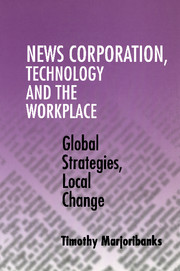Book contents
- Frontmatter
- Contents
- List of Tables and Figures
- Acknowledgements
- Abbreviation
- Introduction: Tales from the Workplace
- Part I Technological Innovation and Workplace Reorganisation: The Newspaper Industry
- 1 Global Technology and the Local Workplace: A Theoretical Debate
- 2 The Institutional and Societal Context: Britain, Australia and the United States
- 3 The Newspaper Industry: Historical Developments in the Three Countries
- Part II Technological Innovation and Workplace Reorganisation: News Corporation
- Bibliography
- Index
3 - The Newspaper Industry: Historical Developments in the Three Countries
Published online by Cambridge University Press: 04 August 2010
- Frontmatter
- Contents
- List of Tables and Figures
- Acknowledgements
- Abbreviation
- Introduction: Tales from the Workplace
- Part I Technological Innovation and Workplace Reorganisation: The Newspaper Industry
- 1 Global Technology and the Local Workplace: A Theoretical Debate
- 2 The Institutional and Societal Context: Britain, Australia and the United States
- 3 The Newspaper Industry: Historical Developments in the Three Countries
- Part II Technological Innovation and Workplace Reorganisation: News Corporation
- Bibliography
- Index
Summary
A number of studies have examined the influence of new technology on workplace relations in the newspaper industry. In addition to presenting the histories of particular newspapers and biographies of newspaper proprietors, these studies have focused on particular actors in the newspaper industry, including print and production workers and their unions; journalists and their unions; and management and proprietors.
Studies of print workers in the newspaper industry have emphasised the degree of control and influence that these workers and their unions have historically exercised in the workplace. Print unions have been able to control the supply of labour and skills in the industry through apprenticeships, and define their own jurisdiction in the face of opposition both from employers and other unions. Studies of the contemporary newspaper industry suggest, however, that developments in computer technology have transformed the skill requirements of the print process, resulting in a shift in the balance of power in the newspaper workplace from print unions to employers. In particular, computer technology has removed the need for craft skills, so that the work of a printer can be accomplished by any individual with basic computer literacy (Cockburn 1991; Cornfield 1992; Emery, Emery with Roberts 1996; Frenkel 1990; Griffin 1984; Kalleberg et al. 1987; Merrill 1995; Scott 1987; Zeitlin 1985).
Another group of studies has examined the influence of technology on the work of journalists, arguing that the consequences of technological developments for these workers may be very different than for print workers.
- Type
- Chapter
- Information
- News Corporation, Technology and the WorkplaceGlobal Strategies, Local Change, pp. 57 - 90Publisher: Cambridge University PressPrint publication year: 2000



